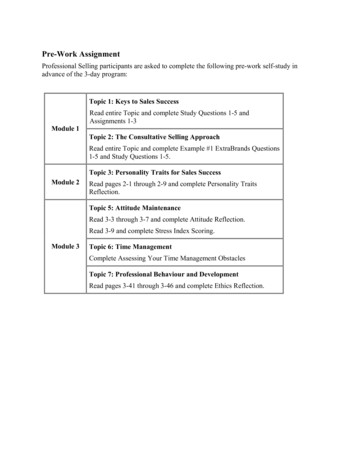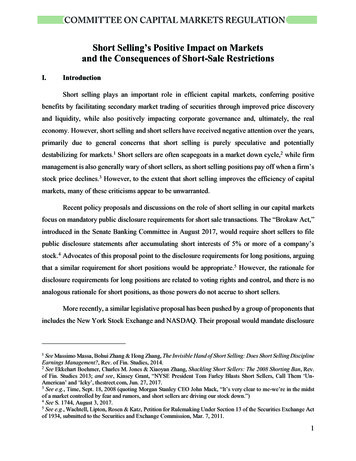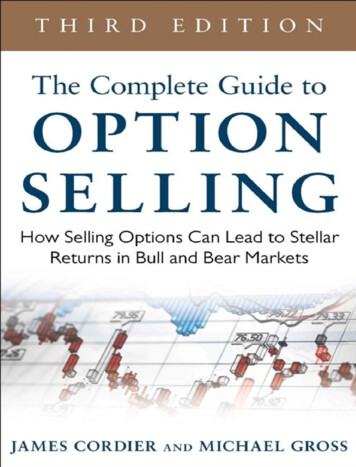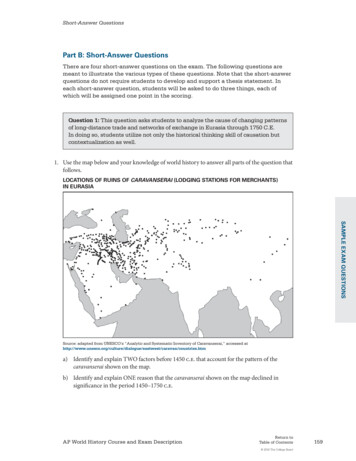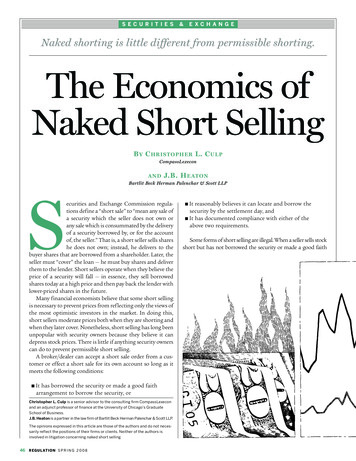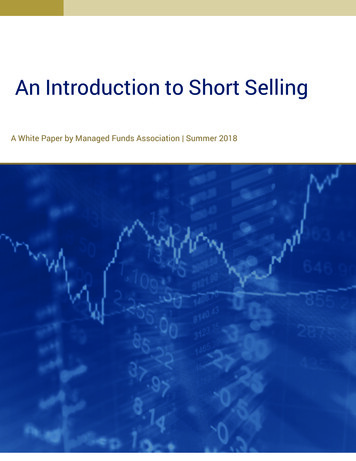
Transcription
An Introduction to Short SellingA White Paper by Managed Funds Association Summer 2018 1
MANAGED FUNDS ASSOCATIONTHE VOICE OF THE GLOBAL ALTERNATIVEINVESTMENT INDUSTRYMFA is the leading voice of the global alternative investment industry and its investors– the public and private pension funds, charitable foundations, university endowments,and other institutional investors that comprise nearly 65 percent of our industry’sassets. Collectively, MFA Members manage more assets than any other hedge fundtrade association. Our global network spans five continents and includes more than9,000 industry professionals.ADVOCATE - We promote public policies that foster efficient, transparent, and fair capitalmarkets. With the strategic input of our Members, we work directly with legislators,regulators, and key stakeholders in the U.S., EU, and around the world.EDUCATE - Each year we hold more than 50 conferences, forums and other events thatgive our Members the tools and information they need to thrive in an evolving globalregulatory landscape. Our expertise has additionally been recognized by policymakers,who consistently reach out to our team for insight and guidance.COMMUNICATE - We tell the story of an industry that creates opportunities andeconomic growth. Through outreach to journalists and thought leaders, we informcoverage of our industry and highlight the work our Members do to provide retirementsecurity for workers, capital for businesses, and increased resources for endowmentsand foundations.To learn more about us, visit www.managedfunds.org.
Table of ContentsI.Foreword.2II.Introduction & Key Takeaways.3III.What is a Short Sale?.4IV.How Do Investors Borrow Securities for Short Sales? .6V.How Does Short Selling Affect Investors, Companies,& Markets?.7VI.How are Short Sales Regulated?.9VII. Short Sale Reporting & Long Position Reporting.13VIII. Conclusion.16 1
I. ForewordUby Richard H. Baker, President and CEO, Managed Funds Association.S. capital markets are the deepest,most liquid, and most efficient inthe world. They have propelled theUnited States to be the world’sleading financial center and helped sustain oureconomic growth, even in the face of strongheadwinds that have slowed recoveries inother countries.These benefits are important on a macro-economic, globalscale. But there is a more micro – or Main Street – reason whyhaving strong financial markets is important: they help meetthe financial needs of local communities. From start-ups to small businesses, homeownership toconsumer purchases, strong markets facilitate commerce, job creation, and growth.Short selling is an integral part of a carefully regulated, well-functioning market. Regulators haverecognized the vital role short selling plays and acknowledged that the cost of banning this activityappeared to outweigh the benefits.Like so many other aspects of our daily lives, markets function best when they represent thebroadest possible set of views. Short selling allows investors to say when they believe an assetis overvalued. This contributes to price discovery. The more efficient a market is at determiningprices, the better it will function for investors. One way to think about this important process isto compare it to buying a house. You research the neighborhood and check prices of comparablehouses before making an offer – and the value you put on the house is sometimes lower than theprice on the listing. This is why appraisals are required by your bank: they do not want you to paymore than it is worth.If investors think markets can only go up, the price of that stock would continue to increase,creating a bubble that eventually has to pop – putting practically every investor at risk. This iswhat happened following the speculation of the dot-com bubble during the late 1990s. When thatbubble burst, stock prices quickly returned to a fair-market value. Investors watched the valueof their retirement accounts plummet. When long buyers and short sellers counterbalance eachother, prices are more likely to reflect the actual value of the assets. Eliminating short sellingskews this balance.Permitting short selling, particularly with our robust regulatory framework, means that investorscan manage risks better and markets can factor in the broadest possible views about a particularstock, bond, or index – reducing the likelihood of future bubbles forming. This helps keep ourmarkets liquid and efficient, which in turn keeps our economy humming.The following paper provides an introduction to short selling and how it is regulated to helpensure investor protections and prevent abuse. In addition, the paper explores the benefits shortselling provides investors as both a risk management tool and a way to meet financial obligationsregardless of market conditions.
AN INTRODUCTION TO SHORT SELLINGII. IntroductionShort selling is an important strategy used by investors,including fiduciaries managing others’ assets. Marketparticipants engage in short selling for differentreasons, including to manage risk, hedge portfolios,and reflect a view that the current market price of asecurity is above its fair value.The goal of this paper is to demystify short selling andexplain how, through appropriate regulation, it leads tohealthier markets for investors and companies.Key Takeaways Investors use short sales for many purposes,including to express a view that a stock isovervalued based on fundamental analysis, tohedge different types of risk in their portfolioand to reduce volatility. Market makers useshort sales to facilitate investors’ buying andselling stocks. Short sales of all types lead to significantbenefits for investors, companies, andmarkets. They can have a stabilizing effect onthe market and are not the cause of rapid pricedeclines of stocks. Similarly, short sellingdoes not increase volatility during periods ofmarket stress. Short selling activities are federally regulated.The SEC has adopted a comprehensive setof regulations and reporting requirementsdesigned to prevent abusive practices. Short sales are distinct from long investmentsand accordingly are disclosed to the public onan aggregate basis. Disclosure of individualinvestor short positions would likely lead tonegative consequences for investors andcompanies. 3
III. What is a Short Sale?a short sale. Later, Company A’s stock price declinesto 50 a share, and the investor buys shares back inorder to return the borrowed shares. Since the price islower, the investor profits on the difference – 10 pershare (minus transaction costs and interest paid to thelender). However, if the price of Company A’s stock goesup, the investor must buy back shares at a higher priceand will lose money.1In a short sale, an investor borrows a security andsells it, then later buys back the security and returnsit. Typically, the short seller borrows the security froma broker-dealer or an institutional investor, such as amutual fund, pension fund, or insurance company. Theshort seller ultimately closes out the short position bypurchasing the security on the open market (or by usingan equivalent security it already owns), and returns thesecurity to the lender.Short sales play an important role in our markets andare quite common. In fact, the SEC has found that shortsales account for approximately 49 percent of listedequity share volume.2For example, an investor may believe that the stock priceof Company A is overvalued. Company A is trading at 60per share, so the investor borrows shares of Company Astock at 60 per share and immediately sells them inWHAT IS A SHORT SALE?123Company ACompany ACompany ABORROWSELLBUY 60Investor believesstock isovervaluedInvestor borrowsstock at currentprice45 60Investor sellsborrowed stock 50Stock pricegoes downInvestor buys stockback at new price6Investor returnsstock and profits thedifference1See Key Points About Regulation SHO, Securities and Exchange Commission, available at: http://www.sec.gov/investor/pubs/regsho.htm.2 See Study on Short Sale Position and Transaction Reporting, SEC Division of Economic and Risk Analysis (June 2014) (“SEC Staff Study”), available at: transaction-reporting%2C0.pdf.4 www.managedfunds.org
Why Are Short Sales Used?Short sales are used to: Express a view about the value of a company.Investors engaging in fundamental researchtypically analyze and interpret public informationto determine if they believe a stock is under orovervalued. If they believe a stock is undervalued,investors purchase the stock, while if they believeit is overvalued, they sell the stock. If investors donot own the stock they determine is overvalued,they can sell it by means of a short sale. Balance investments. An investor with a shortposition in a company may later take a longposition in the company. An investor engaged infundamental and extensive research is often ableto determine when he/she believes a companyhas become undervalued and change from ashort position to a long position. Hedge different types of market exposures. Forexample, an investor with a long position in thestock of Beverage Company A may also take ashort position in the stock of Beverage CompanyB. The short position is designed to eliminate therisk in the long position of Beverage Company Athat the beverage industry underperforms themarket. It is not an indication that the investorbelieves Beverage Company B is overvalued. Reduce the total exposure of a long portfolio tothe broader market. By taking short positionsin a basket of stocks, an index, or an ETF, shortsales allow investors to minimize the general riskthat markets will go up or down. Reduce risk in positions in the same company. Ina convertible bond arbitrage strategy, an investorpurchases convertible bonds of a companyand also sells short the company’s stock. Aconvertible bond can be converted into stock ata pre-determined time and price. In this strategy,the investor uses short sales to reduce some ofthe risk of holding the convertible bonds. Facilitate market making. In addition to investors,market makers also use short selling. Marketmakers are broker-dealers that stand ready tobuy and sell stocks on a regular basis at a quotedprice. Market makers sell short when fillingcustomer orders for stocks that they do notalready hold in their inventory. Market makersalso use short selling to facilitate customerorders in other types of securities, such as equitybased options. Market makers have been foundto account for about 35 percent of short sales.3 Manage portfolio risk. In the alternative, aninvestor could take a short position in the stockof Consumer Goods Company A (or multipleconsumer goods companies) to reduce the risk inthe long position of Beverage Company A that theconsumer goods sector underperforms. Again,the short position does not indicate that theinvestor believes the companies are overvalued;rather the short position is an insurance policyagainst market downturn in that sector.3Id. 5
IV. How Do Investors Borrow Securities for Short Sales?Securities lending is an important part of the short sellingprocess. If an investor sells short and does not arrangeto borrow the security, the buyer of the security wouldnot receive the security. This is called “naked shorting”and results in a “failure to deliver” (i.e., the seller fails todeliver the security to the buyer). As explained in moredetail below, SEC rules generally prohibit naked shorting.Broker-dealers and institutional investors often lendsecurities in connection with short sale transactions.Typically, an institutional investor will lend securitiesto a broker-dealer, which will relend the securities to aninvestor for short selling. An institutional investor cangenerate significant income by lending its securities.The short selling customer will secure its obligation toreturn the borrowed security to its broker-dealer lenderby posting the short sale proceeds and an additionalamount (called margin) with the broker-dealer. Thebroker-dealer borrower, in turn, secures its obligation toreturn the borrowed security to the institutional lenderby pledging cash or non-cash collateral. Institutionallenders receiving cash collateral typically reinvest it togenerate interest income.Market conditions determine what the borrower will pay.If the security is generally available to be borrowed inthe securities lending market, the institutional lenderwill rebate to the broker-dealer borrower a small amountbased on an interest rate. If the security has limitedavailability to be borrowed, the broker-dealer borrowermay have to pay the institutional lender a small amount(called a negative rebate). In either case, if the collateralis non-cash, the borrower will also pay the lender a loanfee.4 When the short seller closes out the short sale, he/she purchases the security and delivers it to the lender.The securities lending process is an effective methodfor investors to engage in short selling and forinstitutional investors to act as lenders and generateadditional income for their investors. The broad rangeof institutional investors lending their shares for shortselling is also a clear indication that these investors donot view short selling as detrimental to the price of theshares.HOW DO INVESTORS BORROW SECURITIES FOR SHORT SALES?Lend on Cash Collateral4Re-Lend SecuritiesSee SEC Staff Study at page 5-6.6 www.managedfunds.orgInvestor(for short selling)Proceeds Margin
V. How Does Short Selling Affect Investors, Companies, & Markets?Investors use short selling as a tool to manage risk andreduce the overall economic exposure of an investmentportfolio. Many institutional investors – such aspension funds, endowments, and foundations – investin investment vehicles that engage in short selling as ameans to mitigate overall risk to their portfolios. By usingshort selling in a manner that hedges risk, investors areable to reduce their overall market exposure and achievehigher risk-adjusted returns.Transaction prices best reflect information when investorswho make investment decisions on the basis of estimatesof fundamental value can invest without restrictions orcosts. If fundamental investors do not own the stock theydetermine is overvalued, they can sell it by means of a shortsale. In this way, fundamental investors, such as hedgefunds, some mutual funds, and others, contribute to priceefficiency through the use of short selling.8Markets are More Liquid & Less Volatile for InvestorsHow Short Selling Helps Investors &Promotes Healthier Markets: Increases Price Efficiency Provides Market Liquidity Promotes Capital Formation Reduces Price BubblesShort selling helps markets function efficiently byincreasing price efficiency,5 providing market liquidity,6promoting capital formation, and potentially reducingeconomy-damaging price bubbles. The SEC and theacademic community regularly affirm these importantbenefits to investors, companies, and markets.7 Below isa short description of how these benefits help investorsand lead to healthier markets.Stock Prices are More AccuratePrice efficiency is a measure of how accurately marketprices reflect available information. A security’s price isdeemed to be efficient if it accurately reflects marketparticipants’ collective opinion of its fundamental value.An efficient price would reflect both optimistic andpessimistic investor opinions.Market liquidity is the ability of trades to occur inreasonably large amounts at or near the market price.A liquid security is one in which buyers and sellers cantransact in reasonably large sizes with only a minimalimpact on the price of the security.Short selling promotes market liquidity through differentmethods. One method is through market makers who fillcustomer orders for securities. Short selling by marketmakers helps offset imbalances in the flow of buy andsell orders, when demand would otherwise exceedsupply.It is a widely held misconception that shortselling increases market volatility during timesof extreme market stress, leading to accelerateddeclines in prices. In fact, evidence shows thatduring a price decline, short sellers will oftensell less, or close out their short positions bypurchasing shares of the security, which offsetssales by long position holders.Perhaps even more importantly, short selling suppliesliquidity and reduces volatility when short sellers tradein the opposite direction of price movements. It is awidely held misconception that short selling increases5See, e.g., Ekkehart Boehmer & Julie Wu, Short Selling and the Informational Efficiency of Prices, (Working Paper, Aug. 16, 2010), available at: http://ssrn.com/abstract 972620.6See SEC Staff Study at Appendix E (“The academic literature provides ample theoretical support for, and empirical evidence of, the importance of short selling forliquidity.”).7Id. (“Theoretical studies support the notion that short sellers promote price efficiency, finding that restrictions on short selling should lead to less accurate prices, highervolatility, and should hinder price discovery.”).8See SEC Staff Study at page 11. 7
market volatility during times of extreme market stress,leading to accelerated declines in prices. In fact,evidence shows that during a price decline, short sellerswill often sell less, or close out their short positions bypurchasing shares of the security, which offsets salesby long position holders.9During the financial crisis, for example, there wereclaims that short selling was responsible for significantdeclines in shares of financial companies. In response,the SEC in September 2008 adopted a temporary banon short sales of financial companies. The “protected”class also included many companies beyond financials.During the temporary ban, however, the shares ofthese companies continued to decline and did notappear to be affected by the ban.10Following the ban, SEC staff analyzed data on shortselling activity during the volatile period in earlySeptember 2008 that prompted the SEC to adopt theban. SEC staff found that the results were not consistentwith the claim that episodes of extreme negative returnswere caused by short selling activity. In fact, the analysisconcluded that short sale volume is higher for periodsof positive returns than for periods of negative returns.11After the ban, then-SEC Chairman Christopher Coxindicated that the costs of the ban appeared to outweighthe benefits, and that he would have been unlikely toadopt the ban based on this information.12Then-SEC Chairman Christopher Cox indicatedthat the costs [associated with a short selling ban]appeared to outweigh the benefits.the allocation of capital to its most productive uses,which facilitates capital formation.When a stock is overvalued, the expected return impliedby its price is too low, which leads to an artificially low costof capital. For example, if some stocks are overvalued,too much capital is likely to be allocated to thesecompanies. The result is that overvalued companiesmay fund less profitable or unprofitable projects, whileprofitable projects could go unfunded by companieswhose stock is undervalued.Short selling also facilitates capital formation bycontributing to more liquid markets. Liquid marketspromote capital formation because investors preferto invest capital in markets with low transaction costsand in which they can quickly establish and liquidatepositions.Reduces the Risk of Market BubblesFrom a long-term perspective, stocks that are overvaluedpresent a problem for the economy. The market willeventually correct the mispricing, but in the meantime,real resources may flow to the overvalued stock orindustry. Perhaps the best example was the housingbubble that popped in 2008. Investments in mispricedreal estate led to long-term disruptions in the realeconomy long after the bubble was corrected. Anotherexample was the dot-com bubble, where marketscorrected overvalued stocks in a relatively short periodof time but firms and employees took much longer torecover.13The absence of short selling in those cases could havemade the situation worse. Short selling also helpsreduce the risk of future market bubbles.Capital is More Efficiently Allocated to CompaniesIn promoting price efficiency, short selling also improves9See, e.g., Daniel Aromi and Cecilia Caglio, Memorandum from SEC Office of Economic Analysis to SEC Chairman Christopher Cox on Short Selling Activity During theFirst Weeks of September 2008 (Dec. 16, 2008), (“SEC Memorandum”) available at: f.10 See, e.g., Robert Battalio, Hamid Mehran, and Paul Schultz, Market Declines: What Is Accomplished by Banning Short-Selling?, Federal Reserve Bank of New York,Current Issues in Economics and Finance, vol. 18, no. 5 (2012) (“The preponderance of evidence suggests that the bans did little to slow the decline in the prices offinancial stocks.”) (“Federal Reserve Short Selling Paper”), available at: arch/current issues/ci18-5.pdf.11 See SEC Memorandum (“We find that for all but one subgroup, short selling is higher during periods of extremely positive returns than in periods of extreme negativereturns . . .These findings indicate that, on average, short seller’s intraday activity is contrarian. On average, short sales seem to decrease intraday volatility by selling relativelymore during periods of positive returns.”).12Rachelle Younglai, Reuters, SEC Chief Has Regrets Over Short-selling Ban (Dec. 31, 2008).13See Federal Reserve Short Selling Paper at page 2.8 www.managedfunds.org
VI. How are Short Sales Regulated?The SEC regulates short sales primarily throughRegulation SHO, which became effective in 2005.Regulation SHO modernized short selling regulation byaddressing concerns regarding persistent failures todeliver and potentially abusive naked short selling.As noted above, in a naked short sale, the seller doesnot borrow or arrange to borrow the securities in time tomake delivery to the buyer within the standard three-daysettlement period. As a result, the seller fails to deliversecurities to the buyer when delivery is due (a failure todeliver).Failures to deliver can also occur for legitimate reasons.For example, human or mechanical errors or processingdelays from transferring securities in physical certificaterather than book-entry form could cause a failure todeliver on a long sale. For short sales, market makersthat sell short a thinly traded, illiquid stock in responseto customer demand may have difficulty obtainingsecurities in time for delivery.The SEC designed Regulation SHO to address concernsassociated with failures to deliver and it has furtheramended Regulation SHO to strengthen its requirementsand eliminate certain exceptions.As amended, Regulation SHO imposes the followingrequirements on short selling: Rule 200 – Marking Requirements: Rule 200 requiresthat orders placed with a broker-dealer must bemarked “long,” “short,” or “short exempt.” Rule 201 – Short Sale Price Test Circuit Breaker :Rule 201 is designed to prevent short selling fromdriving down further the price of a security that hasalready experienced a significant price decline andto facilitate the ability of long sellers to sell firstupon such a decline. The rule restricts the price atwhich short sales may be effected when a stock hastriggered a circuit breaker by experiencing a pricedecline of at least 10 percent in one day. When thecircuit breaker is in effect, a person may not executea short sale at a price that is less than or equal tothe current price. Once the circuit breaker has beentriggered, the price test restriction will apply to shortsale orders in that security for the remainder of theday and the following day. Rule 203(b)(1) and (2) – Locate Requirement: Rule203 requires a broker-dealer to have reasonablegrounds to believe that a security can be borrowedso that it can be delivered on the delivery date beforeeffecting a short sale order in any equity security(known as a locate). This locate must be made anddocumented prior to effecting the short sale. Rule 204 – Close-out Requirement: Rule 204 requiresbroker-dealers to close out failure to deliver positionsby purchasing or borrowing securities of like kind andquantity. The broker-dealer generally must close outa failure to deliver for a short sale transaction by nolater than the beginning of regular trading hours onthe settlement day following the settlement date.In October 2008, the SEC supplemented the RegulationSHO framework to prevent failures to deliver by adoptingRule 10b-21, an antifraud rule under the SecuritiesExchange Act of 1934 (Exchange Act). This rule prohibitsa customer from deceiving a broker about its intentionor ability to deliver a security before the settlement date.Rule 10b-21 reinforces Regulation SHO by imposingadditional liability on a person that fails to deliver asecurity on or before the delivery date.The Regulation SHO framework for short selling hasworked exceedingly well in reducing failures to deliver. In2011, for example, the SEC’s Division of Risk, Strategy andFinancial Innovation, found that since 2008, failures todeliver had declined by 65.7 percent across all securities,and failures to deliver had declined by 85.1percent forthreshold stocks (shares with persistent failures todeliver).1414See Memorandum from SEC Division of Risk, Strategy and Financial Innovation, Impact of Recent SHO Rule Changes on Fails to Deliver (Apr. 25, 2011), availableat: 42511.pdf. 9
Overall, Regulation SHO has been effective in preventingpotentially abusive short sale activity. In fact, the SEChas noted that short selling abuse is less common thanother types of market abuse.15Overall, Regulation SHO has been effective inpreventing potentially abusive short sale activity. Infact, the SEC recently noted that short selling abuseis less common than other types of market abuse.In addition to Regulation SHO, those engaged in shortselling are subject to the broad anti-fraud provisionsof the federal securities law, such as Rule 10b-5 underthe Exchange Act, which prohibits any manipulativeconduct, including intentional dissemination of falseinformation. The SEC has extensive authority toinvestigate and punish fraudulent conduct.Information Reported on Short SellingActivity: Twice-monthlypubliclyavailableshortinterest information for individual stocks. Publicly available daily aggregate short salevolume for individual stocks. Institutional investor short sale tradinginformation maintained by broker-dealersand available to the SEC upon request. Short selling and other trading data uponimplementation of the SEC ConsolidatedAudit Trail that will be accessible by the SECand other regulators.How Are Short Sales Reported?In addition to Regulation SHO, the SEC oversees shortsales through an extensive system of reporting. There isa substantial amount of information about short salesthat is publicly available, and more information is readilyavailable to regulatorsTaken together, this information gives regulators quick,easy access to aggregate, market-wide short saleinformation.The Financial Industry Regulatory Authority (FINRA),which is the self-regulatory organization (SRO) thatregulates and oversees broker-dealers pursuant toSEC oversight, plays an important role in short salereporting. As the SRO for broker-dealers, FINRA collectsshort interest information in individual securities frombroker-dealers and aggregates the information. FINRArequires that broker-dealers report short positions in allequity securities twice monthly through its online filing.In a process that takes approximately 11 days after thesettlement date, or two weeks after the last trading datefor the short positions, FINRA validates and aggregatesthe information and, along with the NYSE and NASDAQ,publishes it.16In addition to the short interest reports, FINRA alsopublishes two other short selling reports in conjunctionwith stock exchanges. One report is comprised of the dailyaggregated short sale volume in individual securities.A second report provides individual short sale transactionsin all exchange-listed equity securities. These data setsare published by FINRA and/or the stock exchanges onno more than a one-month delay and can be found ontheir websites.1715 See SEC Staff Study at page 74 (“There were 273 Commission enforcement actions from 2004 through 2010 than involved market manipulation. Of these, only 14%involved short-side manipulation while 86% did not involve short selling.”)16This information is available at: ort-Interest and 17Links to the short selling data sets can be found at http://www.sec.gov/answers/shortsalevolume.htm.10 www.managedfunds.org
In 2011, the SEC adopted a rule that requires brokerdealers to maintain additional information about thetrading activities of large traders.18 Under the rule, brokerdealers for large traders are required to maintain recordsof transactions effected through accounts of such largetraders and electronically report these transactions tothe SEC upon request through the Electronic Blue Sheetssystems that are used for reporting trade information.19This reporting system has enhanced the SEC’s ability toquickly access trading data from such large traders.The SEC also has broad authority to request short sellinginformation from its registrant
Short selling is an important strategy used by investors, including fiduciaries managing others’ assets. Market . participants engage in short selling for different reasons, including to manage risk, hedge portfolios
